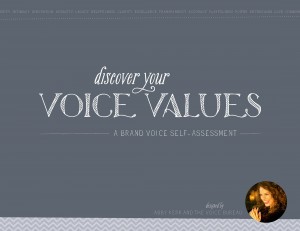This is an installment of The Voice Bureau’s blog post series on Writing Your Smart, Empathetic Website. This series is written with active and aspiring brand creators in mind — those of you who know that your website should be your business’s hardest working “salesperson” — and want to make that more of a reality. This series is geared toward Click here to visit the intro to this series, and to find links to all the other installments.
Chances are, if you’ve been in business for a bit, you’ve done an ideal client profiling exercise or two.
 How’d it work for you? Were you able to translate the insights you gained directly into an actionable page on your website? If not or not yet to your own expectations, please read on.
How’d it work for you? Were you able to translate the insights you gained directly into an actionable page on your website? If not or not yet to your own expectations, please read on.
It’s time we talked about writing a mighty, nuanced, actionably useful Is This You page.
It’s never about tuna vs. pastrami. Unless you’re a deli.
Here at The Voice Bureau, we LOVE writing Is This You pages. It’s astounding, surprising, and fun to find the things to say about YOUR Right People that no one else would say about theirs, because they’re things that are only pretty much true of YOUR people. And yet, astonishingly, they tend to have a universality to them that has deep appeal. (This automatically solves the If I get specific about exactly who I want to work with, will I be leaving too many people in the dust? Nope. Just the Not Quite Right People and the Wrong People Who Think They’re Your Right People, both of whom will make your business not so fun to own and run anyway.)
The most common argument against having an Is This You page is that if the site/the copy/the brand is doing its job, the ‘who this is for’ should be obvious, should take care of itself. I agree with this assertion.
But I simultaneously exhort you to be clear, upfront, and specific about who the brand WANTS to attract — especially for service-based and practice-based business owners, like life, health, and business coaches; business and life guidance consultants; psychotherapists and counselors; teachers, mentors, and advisers; creative professionals like graphic designers, web designers, copywriters, and editors, as well as artists and product designers who work by commission.
For a service provider who practices a unique skill set with a select group of clients or customers, having a fully-feathered brand sans an ‘Is This You’ page is like having a sales page without an Add to Cart button.
Yes, we as online business owners are obliged to be THAT obvious. I mean, why not?
Far from being obnoxiously clear, writing a thoughtfully on-point Is This You page gives the Right People further permission to step forward.
So what sorts of things go on an ‘Is This You’ page to make a meaningful impact — beyond sandwich preference, age range (which may or MAY NOT be important to the work you do and the way you do it), or bland generalities like “you’re smart, insightful, and full of integrity” (honestly, most brand owners would like to say this last one of their Right People)???
Here’s a rundown of what’s important to include on your own business’s is This You page, some items that possibly aren’t important, and a short list of items that are often assumed important but actually aren’t meaningful.
Important To Include On Your Is This You Page:
- stage of readiness for engagement with your brand — where are they, psychologically in terms of readiness, when they arrive at your site? ready to buy now or hire you the same day? just feeling you out? or somewhere in between? (Also: how do you know and why does it matter?)
- familiarity with your topic area or subject of expertise — have they just learned what it is, or are they semi-familiar? are they themselves experts?
- disposition toward buying from a brand or business like yours, or working with someone like you — are they skeptical in general toward your industry? delighted and immediately at home? astute and savvy? (if so, based on what?)
- why they’re interested in learning more about your work and your offers — of all the people who could have landed on your site today, why is this particular Right Person best inclined to stick around and learn more?
- deep, precise dispositions or inclinations that would make this person the best type of Right Person imaginable for the value you provide — don’t go crazy here: this doesn’t need to be a deep psychographic portrait or a laundry list of habits, likes/loves, and predilections; instead, sort for the five or seven strongest, clearest, most concrete and precise intangible qualities that are so specific to YOUR Right Person that you’re pretty sure a competitor couldn’t (or wouldn’t) say the same of his Right People
Possibly Not Important Based On What You Do & How You Do It, But Often Assumed Important By Business Owners & Therefore Seen A LOT on Is This You Pages:
- personality typology — note: I include a LOT of this on my own Is This You page because it’s a deep part of my methodology and approach and relates to the work The Voice Bureau does with clients and course participants, though this may not be the case AT ALL for your business
- gender, age, family composition (“You’re a married mom in her 20s or 30s with little ones at home . . .”) — this may or may not matter based on what you do, how you do it, and why you do it
Not Important Due To Not Being Descriptive & Precise Enough
- “you’ve been looking for the right fit” — this is always pretty much true, and thus, doesn’t need to be said; there’s nothing that says YOU are going to be this random site visitor’s right fit provider (unless you tell them how)
- “you’re ready” — this is so overused it’s practically a buzzphrase
- “you’re smart” — smart takes a lot of forms, so, smart how? and WHY does this particular type of smartness matter to their relationship with your brand?
- “you’ve tried everything and it hasn’t worked” — okay, so your Right Person is highly frustrated? If so, how are you positioning yourself as immediately, perceptibly, and meaningfully different in a way that you can deliver on?
- “you’re ready for something more” — aren’t we all, in our perpetually dissatisfied human state? Even Zen Buddhists want to be less attached. ;)
- “you’re invested in the process” — yes, we ALL want this for our clients when we’re serving 1-to-1, and most clients would say that they are invested, sometimes even despite evidence to the contrary. So in one specific, concrete-detail-filled sentence, what does ‘high investment in the process’ look like on YOUR best Right Person client?
- “you’re looking for results” — most assuredly, none of our Right People are looking to invest tens or hundreds or thousands of dollars with us and get no perceivable results, so this is a given; a values-based business usually has the results part covered, but what you may want to describe here is the type of results your Right Person is most interested in (given that you, indeed, can deliver)
So yes, you really do need an ‘Is This You?’ page! I think you’ll find that writing one moves YOU toward sharper clarity around who you’re serving and why (and who you’re not serving and why, or who you’ve served in the past and why it didn’t work out so well). And once you publish it, I think you’ll be surprised at who shows up, newly convinced that YOU are the coach/consultant/creative/teacher they’ve been looking for this whole time. Watch as a higher percentage of your prospects start to resemble the people with whom you most love to work, and as a higher percentage of your clients strongly resemble what you’ve set forth on your ‘Is This You’ page.
If you’re looking for the next step, check out Writing the Conversational Sales Page, an online course in crafting a long form sales page that sounds like YOU and speaks directly to these Right People you’ve just done such a great job of profiling. We start soon and we’d love to have you along!
In the comments, I’d love to hear:
Do you currently have an ‘Is This You’ you’re happy with? How’s it working for you? What feels like it might need to change?
(Image credit.)
{ 3 comments }



 I’ve developed and methodologized a way for you as a business owner to understand your own brand voice — originating out of your natural communication strengths, but to be beheld as an entity separate, complete, and organic unto itself.
I’ve developed and methodologized a way for you as a business owner to understand your own brand voice — originating out of your natural communication strengths, but to be beheld as an entity separate, complete, and organic unto itself. Hello, you.
Hello, you.